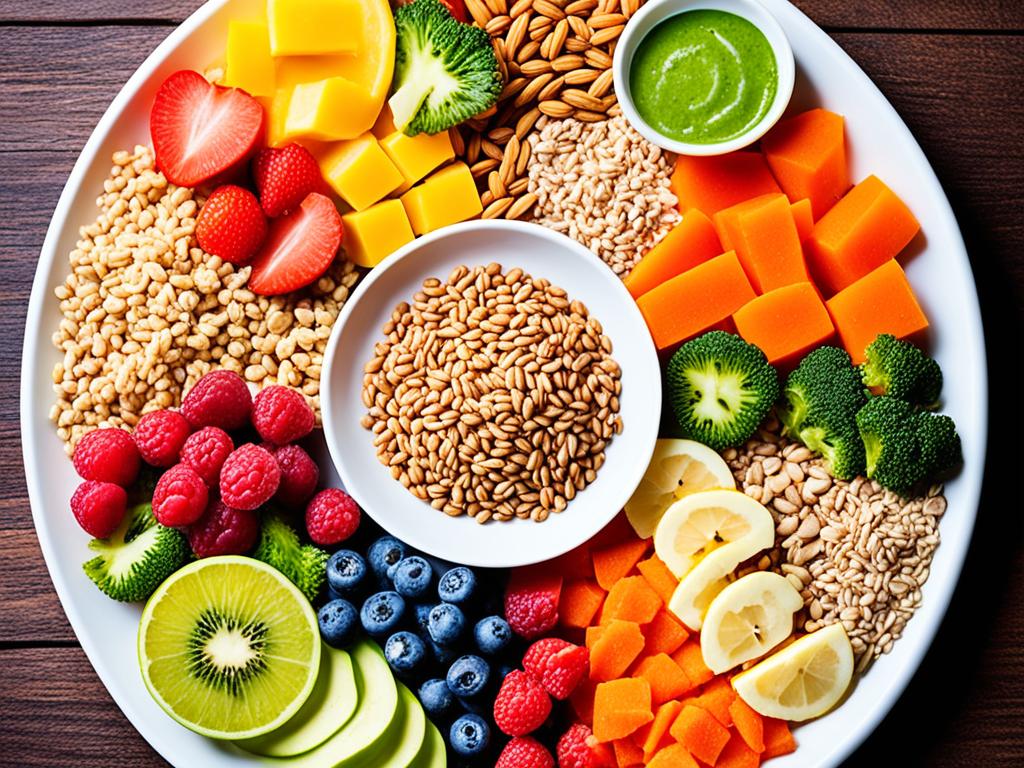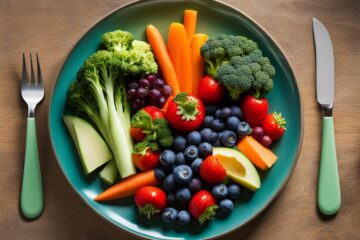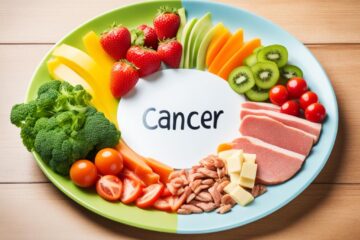Think about your meal and if it really feeds your body well. Do you get enough of the right nutrients? Eating healthy can seem hard sometimes. But don’t worry. This guide will show you the way to the ideal plate.
Learn the key to healthy living by knowing what balanced eating really is. We will talk about macronutrients, micronutrients, the food pyramid, and portion control. This article will help you make smart food choices for your nutrition and well-being.
Start your journey to a healthier life. Learn how every meal and drink can make you healthier. Discover what the ideal plate is and open the door to balanced living.
Key Takeaways
- Understanding the role of macronutrients and micronutrients in a balanced diet
- Exploring the principles of the food pyramid and its impact on healthy eating
- Mastering the art of portion control for optimal nutrient intake
- Calculating your daily caloric needs for weight management and overall wellness
- Incorporating all food groups for a well-rounded and nourishing meal plan
What is a Balanced Diet?
A balanced diet is key for good health and well-being. It includes all the necessary nutrients, both big (macro) and small (micro). Knowing about these nutrients lets you make a diet that keeps you strong and healthy.
Understanding Macronutrients
Macronutrients give our bodies energy. They are carbohydrates, proteins, and fats. Carbs give us energy, proteins help us grow and fix things, and fats help vitamins work and keep our cells healthy.
Importance of Micronutrients
Micronutrients are just as vital for a good diet. These include vitamins and minerals. They do a lot of jobs in our bodies, like keep our immune system strong and help us use energy right. Eating a mix of healthy foods is the smart way to get enough micronutrients.
| Macronutrients | Function | Food Sources |
|---|---|---|
| Carbohydrates | Primary source of energy for the body | Whole grains, fruits, vegetables, legumes |
| Proteins | Building blocks for growth and repair | Lean meats, poultry, fish, eggs, legumes, dairy |
| Fats | Support cell function and nutrient absorption | Nuts, seeds, avocados, olive oil, fatty fish |
Learning about macronutrients and micronutrients helps you plan a balanced diet. It ensures your body gets everything it needs. With this knowledge, you can make smart choices for a healthy eating plan.
L’assiette idéale: Tout ce que vous devez savoir sur l’équilibre alimentaire
Apprenez le concept de l’assiette idéale pour un équilibre alimentaire. On vous dira tout sur comment manger sainement. Cela inclut des conseils pour choisir les bons aliments.
Avoir une alimentation équilibrée est essentiel pour rester en forme. Cela signifie manger les bons niveaux de glucides, protéines, et lipides. Et ne pas oublier les vitamines et minéraux importants.
Manger sain veut dire inclure tous les groupes alimentaires. Cela montre aussi l’importance de la variété et de manger avec modération. On vous guidera pour planifier des repas équilibrés.
On vous aide à manger équilibré, même si votre vie est très active ou si vous avez un budget serré. Cela va aussi selon vos goûts personnels. Préparez-vous pour une vie plus saine avec l’assiette idéale.
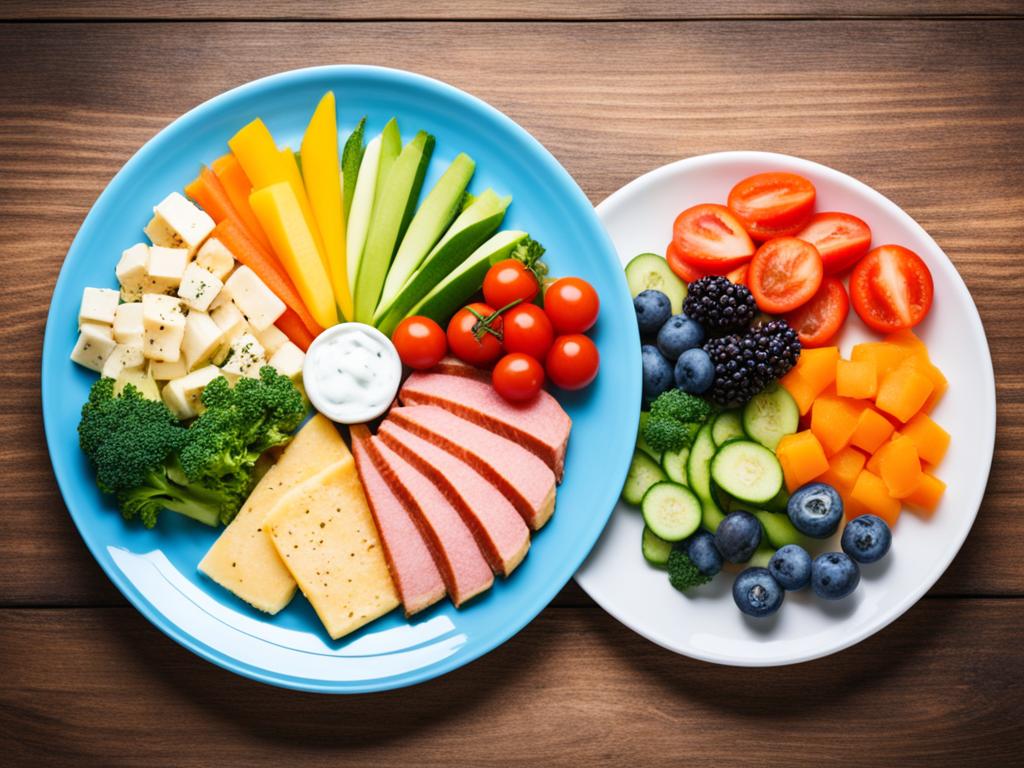
The Food Pyramid: A Guide to Healthy Eating
The food pyramid helps people know how to eat a balanced, healthy diet. It shows us the key food groups like veggies, fruits, grains, starches, and proteins. We’ll look at why these groups are important for our health.
Vegetables and Fruits
Vegetables and fruits are at the bottom of the pyramid. They provide lots of vitamins, minerals, and fiber. Eating plenty of them supports good health. It’s suggested that we eat more of these than any other food.
Grains and Starches
Next, we have grains and starches like bread and pasta. These foods give us energy and many important nutrients. Eating whole grains is best since they have more fiber and nutrients.
Protein Sources
Proteins are crucial, too, and can be from plants or animals. Foods like meats, eggs, beans, and nuts help our muscles, heal tissues, and keep our immune system strong. It’s good to eat a mix of protein sources every day.
Knowing how much of each group to eat is key. With this knowledge, you can make a diet that’s good for you. It will help you stay healthy.
Portion Control: Key to Balanced Meals
To eat a balanced diet, it’s about more than just picking the right foods. It means controlling how much you eat, too. Portion control is vital for making balanced meals. They should give your body the right amount of calories and nutrients.
It’s key to know the right serving sizes for each food type. Eating too much, even if it’s healthy, can throw off your diet. This could mess with your nutrition and wellness goals.
| Food Group | Recommended Portion Size |
|---|---|
| Vegetables | 1 cup raw or 1/2 cup cooked |
| Fruits | 1 medium piece or 1/2 cup chopped |
| Grains | 1 slice of bread or 1/2 cup cooked |
| Proteins | 3-4 oz cooked |
| Dairy | 1 cup milk or yogurt, 1.5 oz cheese |
Following these portion control suggestions with various balanced meals helps ensure a rich nutrition diet. This supports your health and fitness goals overall.
“Portion control is not just about restricting your food intake, but rather about creating a balanced and sustainable healthy eating plan.”
Using portion control can aid in keeping your weight in check. It also lowers the risk of health issues. Try things like portion-controlled plates and paying more attention to how you eat. These help in making portion control a part of your daily life.
Calculating Daily Caloric Needs
Figuring out your daily caloric needs is key to a healthy diet. Your calorie requirements change with age, gender, how active you are, and your metabolism. Knowing this helps with your nutrition and weight management.
Factors Affecting Calorie Requirements
Many things influence your daily caloric needs. These include:
- Age: As you grow older, your metabolism slows down, changing your calorie requirements.
- Gender: Men need more calories than women because they usually have more muscle and are often more active.
- Activity Level: Being more active means you need more calories to sustain that activity.
- Metabolism: The speed at which your body turns food into energy varies, impacting the calories you need.
Online Calorie Calculators
Luckily, there are online calorie calculators to help figure out your daily caloric needs. These tools consider your age, gender, height, weight, and how active you are. They give a custom suggestion for your calorie requirements. This way, you can better grasp your nutrition needs and make smart choices for your health and wellness.
Incorporating All Food Groups
To eat a balanced diet, you need foods from all groups. Including many nutrients in your meals helps keep you healthy. Foods like protein, fruits, and vegetables are all key.
Variety and Moderation
Eating a wide variety of foods is important for balance. Make sure your meals have grains, fruits, and more. This not only tastes good but also makes sure you get all the nutrients your body needs. Remember, eating too much of one kind of food isn’t good.
Meal Planning Tips
Meal planning helps you stick to a balanced diet. Choose which food groups to focus on, and plan a menu for the week or month. Trying new recipes makes meals exciting. Batch cooking or meal prep can make eating healthy easier every day.
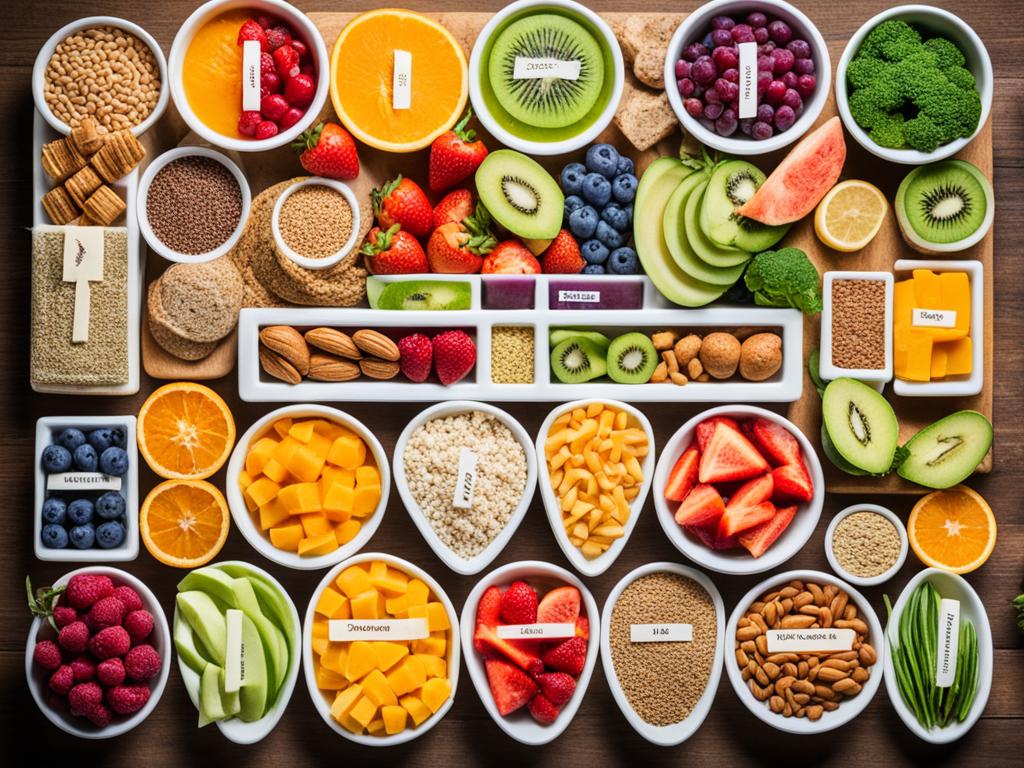
Benefits of a Balanced Diet
A balanced diet is great for your health and mood. Knowing how it helps your body will make you want to eat better. This way, you can stay healthy and happy.
Improved Energy Levels
Eating a balanced diet keeps your energy levels up. With the right mix of carbs, proteins, and fats, your body works well. You feel energized and sharp all day.
Weight Management
Eating right is key for managing weight. It’s not just what you eat, but how much. The perfect mix of foods helps your metabolism. This keeps your calories in check, making it easier to stay at a healthy weight.
Disease Prevention
Choosing the right foods can lower your disease risk. A diet full of fruits, veggies, whole grains, and lean meats works wonders. It gives you the vitamins, minerals, and antioxidants you need. This boosts your immune system and keeps you healthy.
| Benefits of a Balanced Diet | Impact |
|---|---|
| Improved Energy Levels | Consistent energy throughout the day, efficient nutrient conversion to fuel |
| Weight Management | Healthy caloric balance, support for metabolism, desirable weight maintenance |
| Disease Prevention | Reduced risk of chronic diseases, bolstered immune system, overall health benefits |
Overcoming Barriers to Healthy Eating
Eating healthy is not always easy. Daily life can throw up many challenges. These can include being too busy, having certain likes or dislikes, or not having much money. Such hurdles often stand in the way of maintaining a good diet. But, with the right approach, you can still eat well, no matter the obstacle.
Busy Lifestyles
Modern life is fast and full, leaving little time for healthy eating. Work, family, and other duties can push us towards quick, but not so healthy meals. To address this, setting aside time for meal planning is key. Use your weekends to cook in bulk. This way, you’ll have nutritious meals ready all week, even when you’re swamped.
Food Preferences
Your food tastes can complicate matters too. If you don’t like certain foods, or if you’re picky, you might opt for not-so-healthy choices. Yet, you can change this by slowly adding new, nutritious foods to your menu. Play with how you prepare them. Also, get smart about mixing in your favourites to create balanced meals.
Budget Constraints
Money can also be a barrier to eating well. The thought that good food is expensive drives many towards cheaper, less nutritious options. But, being smart with your spending can change this. Buy in bulk, go for frozen or canned produce, and pick locally-grown items. These tricks prove that a balanced diet is affordable for everyone.
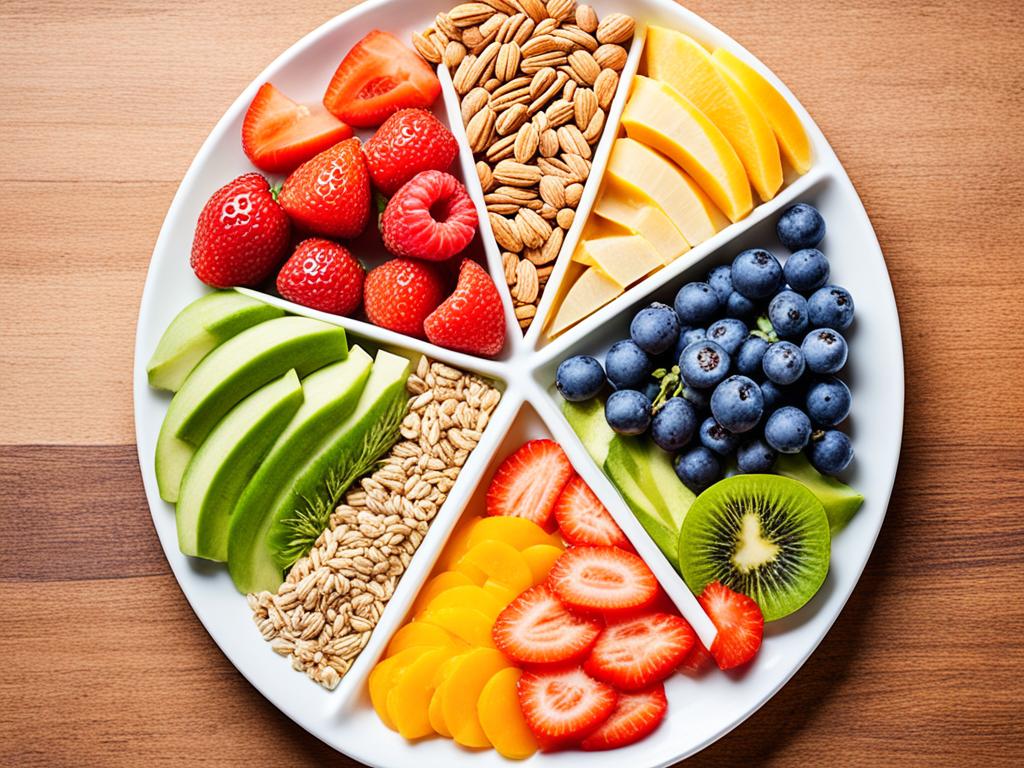
| Barrier | Strategies to Overcome |
|---|---|
| Busy Lifestyles |
|
| Food Preferences |
|
| Budget Constraints |
|
Conclusion
You’ve learned a lot about the importance of balanced eating. You now know how key macronutrients and micronutrients are. Understanding the food pyramid and portion control lets you make smart choices.
A balanced diet is vital for health. It’s not just about the perfect plate. It’s about feeding your body well, getting energy, and staying healthy. By following what you learned here, you start a path to feeling better every day.
We’ve covered the essentials of balanced eating and nutrition. Living a healthy lifestyle is now easier. Make these tips part of your everyday. You’ll quickly see the great results of eating well.
